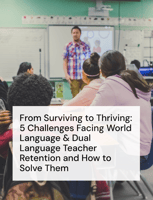By Michelle Olah, Proficiency Paths A few years ago, I met a first-year Spanish teacher at a...
What makes a coaching conversation actually helpful?
Some coaching conversations spark conversation and growth. Others don’t.
If you coach or lead world language or dual language teachers, you’ve probably seen both.
The helpful ones usually feel calm, clear, and honest.
There’s trust. The teacher feels safe.
They walk away with one thing to focus on.
The unhelpful ones often feel rushed, vague, or too focused on fixing.
The teacher nods, but nothing really shifts.
So how do we make the helpful kind happen more often?
There’s no magic formula, but this one mindset has helped me:
Coaching isn’t about delivering feedback. It’s about holding space for growth.
And when I need to keep things simple, I use this acronym: SPARK.
S = Strengths
Start with what’s working. Not as a compliment sandwich. Not to be nice. But because it’s grounding.
It shows you’re paying attention. It helps the teacher feel seen.
When teachers feel judged, they get defensive.
When they feel recognized, they’re more open to reflection.
Tip: Focus on something they did with intention—not just “good energy” or “clear directions.”
Try: “What do you feel proud of from that lesson?”
Or: “I noticed how you built in student interaction right away—what led to that choice?”
P = Purpose
Coaching works best when it connects to what matters to the teacher. Not what’s urgent to you.
Even if you’re hoping to move them toward more target language use, they might be focused on classroom routines—or just surviving right now.
Let their purpose guide the conversation.
Tip: If they’re unsure, help them name a small goal connected to student learning.
Try: “What’s something you’ve been working on lately?”
Or: “What part of your teaching feels most important to you right now?”
A = Assets
This one’s easy to skip—but really matters. We often assume teachers need new tools, when really they need to reconnect to tools they already have.
Maybe it’s a strategy they used in the past. A lesson that worked well. Or a moment of success from earlier this year.
You’re not the expert dropping knowledge—you’re the mirror helping them notice what’s already there.
Tip: When in doubt, ask about something they’ve done that worked.
Try: “Have you used anything like this before that seemed to help?”
Or: “What’s a lesson or activity that’s gone well lately?”
R = Realistic Next Step
Growth happens in small steps. If a teacher leaves the conversation with three action items and no clarity, they’re overwhelmed—not motivated.
Help them pick one thing they want to try. Not the best thing. Not the “right” thing. Just one.
Tip: Frame this as “experimenting,” not “fixing.”
Try: “What’s one thing you’d feel good about trying before our next check-in?”
Or: “If you had to choose one thing to tweak, what would it be?”
K = Knowledge-Seeking
Coaching isn’t about having the answers. It’s about being curious in the right direction.
Ask questions that help the teacher slow down and think. Listen to learn—not to solve.
And don’t be afraid of silence. That’s where thinking happens.
Tip: Avoid rapid-fire questions. Ask one, and give it space.
Try: “What felt challenging about that moment?”
Or: “What do you think your students were experiencing during that part?”
One Last Thing
Coaching isn’t about fixing people. It’s about creating conditions for growth.
You don’t need fancy tools or a script. You just need a structure that helps you listen well, ask better questions, and help teachers think clearly.
If you’d like to learn more about how to use SPARK in real coaching work, I’m hosting a live session soon:
🗓️ Coaching Conversations That Spark Change
📅 July 28 | 10–11 AM EDT
🔗 Register here: https://us06web.zoom.us/meeting/register/gyaEnBHLTnOZn2CVAkBHoQ#/registration
You’ll leave with conversation starters, a coaching cycle template, and a clear next step for your work this year.
Hope to see you there!




